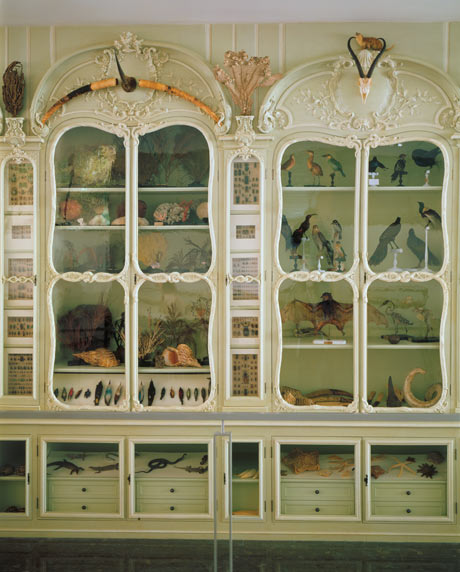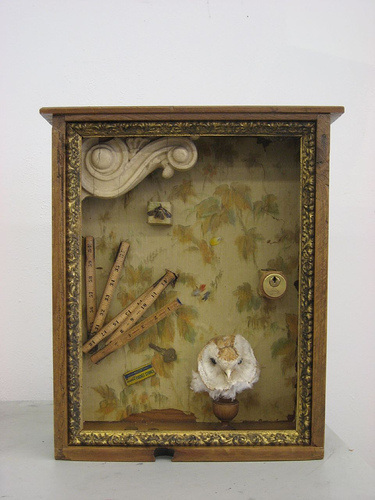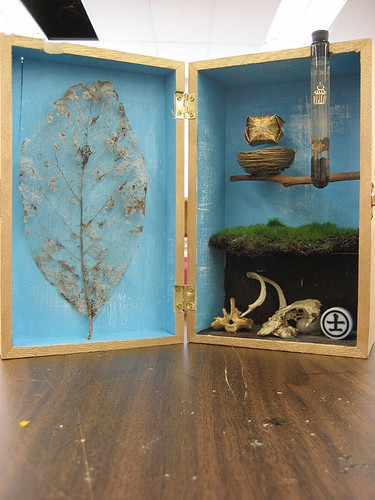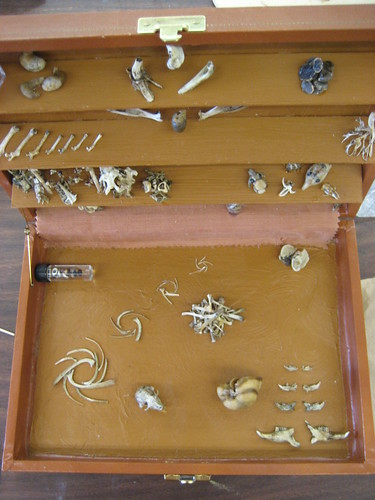 Two weekends ago, I traveled back in time to an age when science and art, nature and religion, and truth and beauty weren't so disconnected as they are now. In the Renaissance, rich men collected natural specimens for display in rooms and cabinets called Wunderkammern.
Two weekends ago, I traveled back in time to an age when science and art, nature and religion, and truth and beauty weren't so disconnected as they are now. In the Renaissance, rich men collected natural specimens for display in rooms and cabinets called Wunderkammern.  They would host parties where guests would philosophize on the structure and order of the natural world. Two notable descendants of the wonder cabinet phenomenon live on today: circus freak shows and natural history museums. A very interesting article in Cabinets magazine presents more history of this phenomenon. For more info or nice photos, check out the Kircher Society, ArtLex, and this blog. World's Fair is even a blog inspired by cabinets of curiosity and wonder rooms.
They would host parties where guests would philosophize on the structure and order of the natural world. Two notable descendants of the wonder cabinet phenomenon live on today: circus freak shows and natural history museums. A very interesting article in Cabinets magazine presents more history of this phenomenon. For more info or nice photos, check out the Kircher Society, ArtLex, and this blog. World's Fair is even a blog inspired by cabinets of curiosity and wonder rooms. My introduction to Wunderkammern was via the Pratt Fine Arts Center. I took an assemblage course called "Assembling The Modern Wonder Cabinet." It was cathartic for me to escape (for a few hours a day, at least) from the lab to engage in an activity more creative and less analytical than my current scientific endeavors. It was also really fun to work in a class environment where everyone was enthusiastic to help each other. Art, like science, can be more meaningful when conducted in a collaborative environment.
My introduction to Wunderkammern was via the Pratt Fine Arts Center. I took an assemblage course called "Assembling The Modern Wonder Cabinet." It was cathartic for me to escape (for a few hours a day, at least) from the lab to engage in an activity more creative and less analytical than my current scientific endeavors. It was also really fun to work in a class environment where everyone was enthusiastic to help each other. Art, like science, can be more meaningful when conducted in a collaborative environment.
I have included here a few images of my colleagues' cabinets. Click on the photos or visit my Flickr page for larger images. We will all be part of a show at Seattle's Center on Contemporary Art from August 25-September 25, 2007. Stay tuned for more information about that.
 My piece (at left) is a 12" x 16" man's jewelry box that opens to reveal an arrangement of rodent parts. The bones were collected and sorted from owl pellets, while the soft tissue is fixed and paraffin embedded, as would be done for tissue specimens in research labs and hospitals. It is titled, Gratiaedonatus oriens. The italicized Latin name evokes the genus and species binomial nomenclature biologists use to classify organisms.
My piece (at left) is a 12" x 16" man's jewelry box that opens to reveal an arrangement of rodent parts. The bones were collected and sorted from owl pellets, while the soft tissue is fixed and paraffin embedded, as would be done for tissue specimens in research labs and hospitals. It is titled, Gratiaedonatus oriens. The italicized Latin name evokes the genus and species binomial nomenclature biologists use to classify organisms.For a directory of the parts displayed and more cabinets, please visit my Flickr page.
This course opened for me many doors to new ideas. It will be fun to explore the intersection of science and art as I assemble future Wunderkammern.
Thanks to Ipei for the pictures.





4 comments:
And, just so the anti-intellectual contingent is represented:
Gwoss.
Love the post, Thomas. I wonder too: there's something about that Kirscher Society -- they keep popping up, in a way as to suggest a meta-curiosity. They point to the beauties of wunderkammern at the same time they are a cabinet unto themselves. Also: Did you see notice of them in The New Yorker's Talk of the Town some months ago? I swear I saw it, but now can't find the issue. Ben
I think you are looking for this article?
Title: WONDER BOYS.
Authors: Seabrook, John
Source: New Yorker; 1/29/2007, Vol. 82 Issue 47, p33-34, 2p, 1bw
Document Type: Article
Abstract: The article examines the first meeting of the Athanasius Kircher Society in New York City in 2007. The piece explains that Kircher, a German Jesuit priest of the 17th century, was thought in his day to be a polyhistor, but later scholarship revealed that his research on a wide number of arcane subjects was seriously flawed. Proceedings of the meeting, which included an address by Anthony Grafton of Princeton University, are described.
From my family's home library:
Building Your Own Nature Museum for Study and Pleasure by Vinson Brown
There is one on eBay with a 'buy it now' price of 80 cents. The book is currently out of print.
The Victorians were really into nature study and nature walks and keeping a nature notebook. A great facsimile of one is "The Country Diary of an Edwardian Lady" by Edith Holden.
Beatrix Potter taught herself to draw animals well by collecting their dead bodies and bringing them home to examine and to draw from. (yuck)
Post a Comment